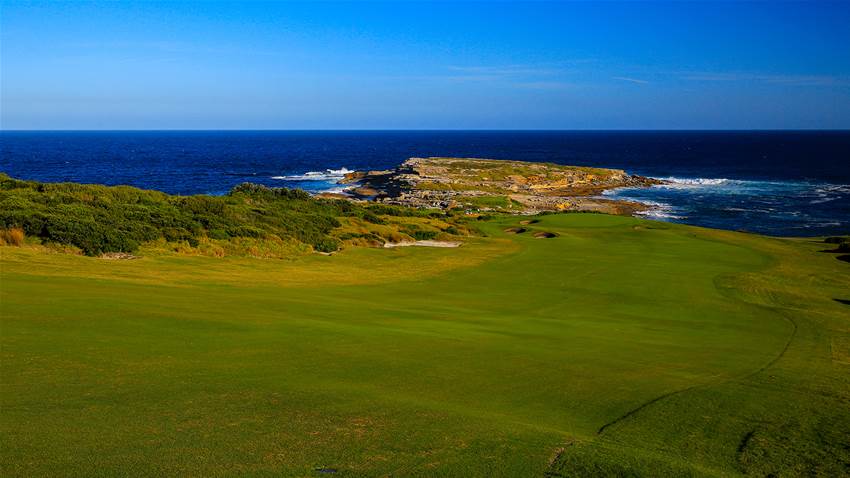On the world’s professional Tours, par-5s aren’t what they used to be. In fact, many are turned into par-4s for tournament play. For the rest of us, they represent lengthy journeys but a good opportunity to improve our score with perhaps a couple of lusty blows and a deft pitch.
ROYAL QUEENSLAND GC
525-metre, 9th hole
A variety of playing lines from the tee, courtesy of the placement of bunkers at different lengths across the fairway, makes every player think about how they are going to navigate their way to the green. The major danger from the tee is the hazard down the left side, but once the golfer clears the driving area, the right side – which is the preferred line into the angled green – is protected by water.
SANCTUARY COVE G&CC – PINES COURSE
522-metre, 11th hole
The course’s trademark pine trees line the entire left side of the fairway, while a creek to the right snakes in and away from the fairway before cutting diagonally in front of the slightly raised green. Three fairway bunkers left and the encroaching creek narrows the fairway the further you progress from the tee. This genuine three-shotter rewards accurate ball-striking.

SANCTUARY COVE G&CC – PALMS COURSE
472-metre, 18th hole
The risk-and-reward aspects here make for a great finishing hole. A birdie is in the making for two perfectly hit shots favouring the left half of the fairway and including a second shot carry over the edge of a greenside lake. A lay-up second shot is best left near a lone fairway bunker about 30 metres short right of the green, as this will take the water out of play for the pitch shot.
TASMANIA
BARNBOUGLE DUNES
475-metre, 11th hole
Often overlooked as a fine par-5 simply because it lies between two memorable holes and also plays shorter in the prevailing wind, forcing the hole to let its guard down … for some. Mis-hits will inevitably find the bunkers left and right of the dramatically rolling fairway, which immediately takes birdie off the table.

BARNBOUGLE DUNES
508-metre, 14th hole
With a fairway set diagonally to the direction of your tee shot. A nest of fairway bunkers right lay on a direct line to the green, while two more bunkers to the left catch the over cautious player trying to take a conservative route. The fairway dips and rolls subtly before turning left and rising to the green, protected by two deep traps left and much larger bunker to the right.
BARNBOUGLE LOST FARM
467-metre, 1st hole
The fairway of Lost Farm’s opening hole is very wide. It is so wide that mis-hits are unlikely to find too much trouble. However, to enhance your chances of making a birdie your drive should skirt the fairway bunkers to the left as this opens up the route into the small green complex.
BARNBOUGLE LOST FARM
554-metre, 8th hole
From the tee, the drive carries long flowing marram grass to reach the angled fairway, which features a hog’s back shape develop the further you travel along the fairway. The fairway narrows between bunkers left and scrub to the right the closer you get to the green. A blowout bunker right and a small pot bunker cut into the steep false front of the putting surface, add to the challenge of making par here.

BARNBOUGLE LOST FARM
543-metre, 10th hole
Long grass covered dunes create a chute from where the tee shot is played to a relatively flat fairway. The high dunes line both sides of the fairway as it turns left towards the green, which is tucked behind a large bunker. A small mound covered in long marram grass looms just right of the angled green.
CAPE WICKHAM LINKS
447-metre, 6th hole
A short par-5 with a wide fairway that plays uphill and usually plays with some kind of right-to-left breeze. The shortest route is in the direction of the crop of fairway bunkers on the right edge of the fairway. This, however, leaves a blind second shot into the green, wedged between bunkers front and a long grass-covered dune behind. The further left you play along the fairway, the more green you get to see but the longer the approach shot becomes.
CAPE WICKHAM LINKS
488-metre, 9th hole
Plays much longer due to the prevailing wind, the fairway lies between high dunes and a nest of deep bunkers. The hole dips dramatically as it turns right around a sandy valley before veering left to the green, set against the base of a high dune. Missing the green left is dead, while any shot long will leave a difficult recovery shot.
CAPE WICKHAM LINKS
532-metre, 15th hole
A long, downhill three-shotter, the 15th is the closest hole you will come to the Cape Wickham Lighthouse during your round. The first part of the hole heads semi-blind across a bunkered crest, ahead of a wide split-level fairway. Those able to hug the more dangerous left side – avoiding four deep bunkers – with their second shots are rewarded with a much easier approach.

OCEAN DUNES
479-metre, 1st hole
The opening fairway plays slightly uphill into the sand dunes, the highest of which features a deep bunker carved out of it. The dramatic left-to-right camber of the dogleg right fairway then leads into a steep drop down towards the oceanside green. It’s a wide green wedged between bunkers in front and the kelp track and breaking waves beyond.

TASMANIA GC
526-metre, 3rd hole
The hole follows the gradual curving foreshore of Barilla Bay to the left and offers an option of shortening the hole by cutting off the corner with your drive. But there is the danger of your ball finishing in the water 50 metres below. This is the most spectacular and hole fun hole to play.
Related Articles

Review: Omaha Beach Golf Club

Column: The Sandbelt never lies







_15th_hole.jpg&h=115&w=225&c=1&s=1)




